Today let’s talk about the administrative division of Polish. Picture this – you’re in the heart of Vistula country, a land that has undergone numerous territorial division reforms. Now, these weren’t just minor tweaks – they happened in 1946, 1950, 1957, 1975 and most recently, in 1999.
Poland’s Districts – A New Division System
This last reform in ’99? Let me say, it was a biggie. It introduced a brand new division of the country into three types of local governments:
- voivodships
- powiats, and
- gminas.
Also, worth to say, the gminas stepped up their game by creating auxiliary units known as village councils.
Being there, you need to know this – the Poland boasts 2477 municipalities. If you’re curious about the breakdown, let me enlighten you. There are 302 urban communes, which are essentially cities with powiat rights. These are tucked within the city’s administrative boundaries and sometimes even form their own districts.
↳ PRO TIP: Do you like traveling? Then before you buy any ticket or book an attraction, check if it's available in this worldwide Viator Database. You may save a lot of money and time. No need to thank me :)
Diverse Municipalities
Allow me to explain further. Among these municipalities, there are what we call urban-rural communes. These are special because they encompass one city and several surrounding villages. In total, we have 642 of these unique territorial units.
Wait, there’s more. We also have 1533 rural communes. By definition, these don’t have a city in their area. Though, sometimes, I think it’s interesting that the Commune Office is located in the nearest town, which is technically in another commune.
Breakdown of Poland’s Administrative Units
So you’re probably wondering, what are the administrative units that divide Poland and „How many voivodships, powiats, and gminas are there in Poland?”
Let me tell you, the numbers are impressive:
- 16 voivodships
- 314 powiats and 66 cities with powiat status
- 2477 communes (comprising 302 urban communes, 652 urban-rural communes and 1523 rural communes).
And there you have it! That’s the breakdown of Poland’s administrative division.
Alright, let’s dive back into the captivating world of Polish administrative divisions. This time, we’re zooming in on the voivodships. Now, you need to know that there are currently 16 voivodships that make up Poland:
- Lower Silesian Voivodeship
- Kuyavian-Pomeranian Voivodeship
- Lublin Voivodeship
- Lubuskie Voivodeship
- Lodzkie Voivodeship
- Lesser Poland Voivodeship
- Masovian Voivodeship
- Opolkie Voivodeship
- Podkarpackie Voivodeship
- Podlaskie Voivodeship
- Pomeranian Voivodeship
- Silesian Voivodeship
- Świętokrzyskie Voivodeship
- Warmian-Masurian Voivodeship
- Greater Poland Voivodeship
- West Pomeranian Voivodeship
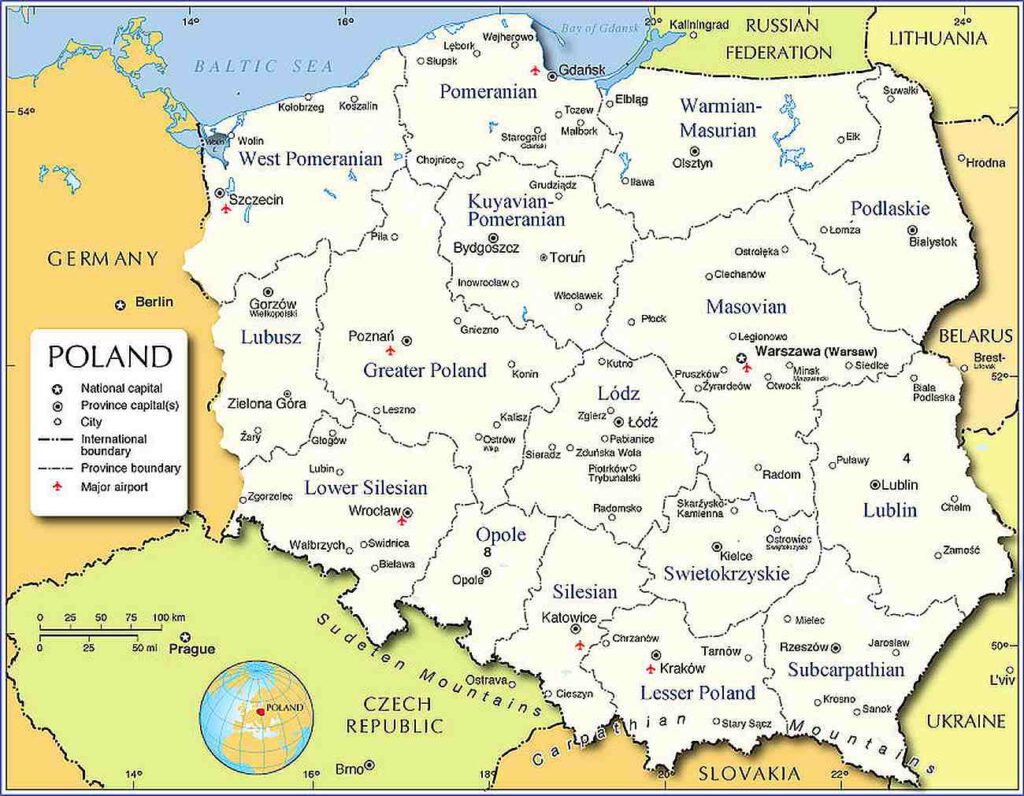
Voivodships – Top Tier
We’re now heading up to the highest unit of territorial division: the voivodships. These hold the highest self-government authority in the country, each one led by a voivode. Now, each voivodship is unique in its area, number of inhabitants, or population density. However, they all have one thing in common: each one has its own separate capital. That’s the city where you’d find the Marshal’s Office and the Voivode.
Masovian Voivodeship
Among these voivodships, the Masovian Voivodeship deserves a special mention. Let me explain why. It’s the largest in the country, covering an impressive 35.5 thousand sqare km of area. This area is filled with 89 cities, 37 powiats, and 314 communes.
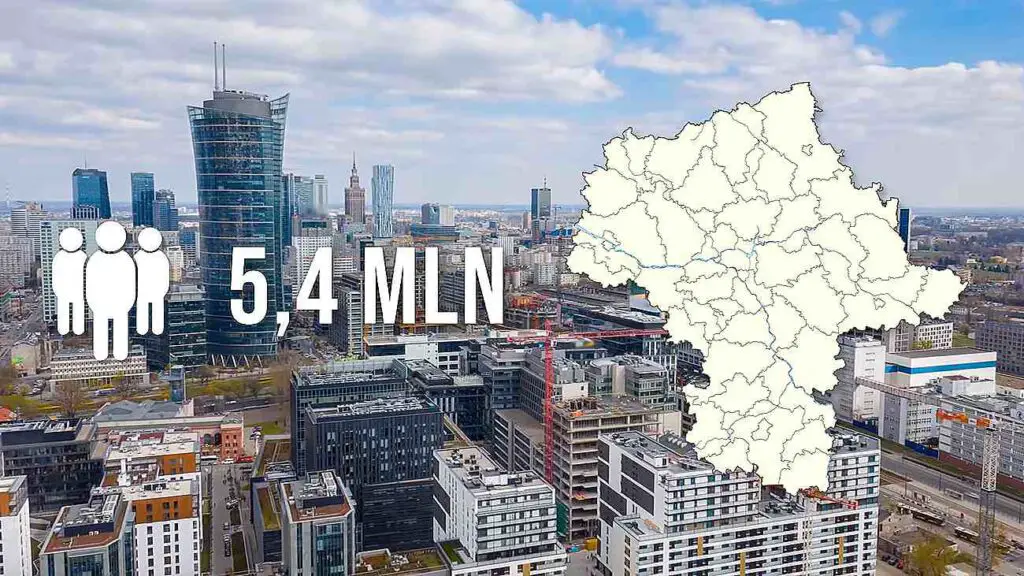
The Masovian Voivodeship is home to about 5.5 million people, giving it the third-highest average population density in the country. We’re talking 150 folks per square km.
Now, here’s an interesting tidbit: about 30% of this voivodship is protected area. We’re talking reserves, national and landscape parks. Plus, it’s a hub for many of the most crucial roads in the country, and the location of the largest companies’ headquarters. And why is that, you ask? Well, it’s all thanks to its capital: Warsaw, which is also the country’s capital.
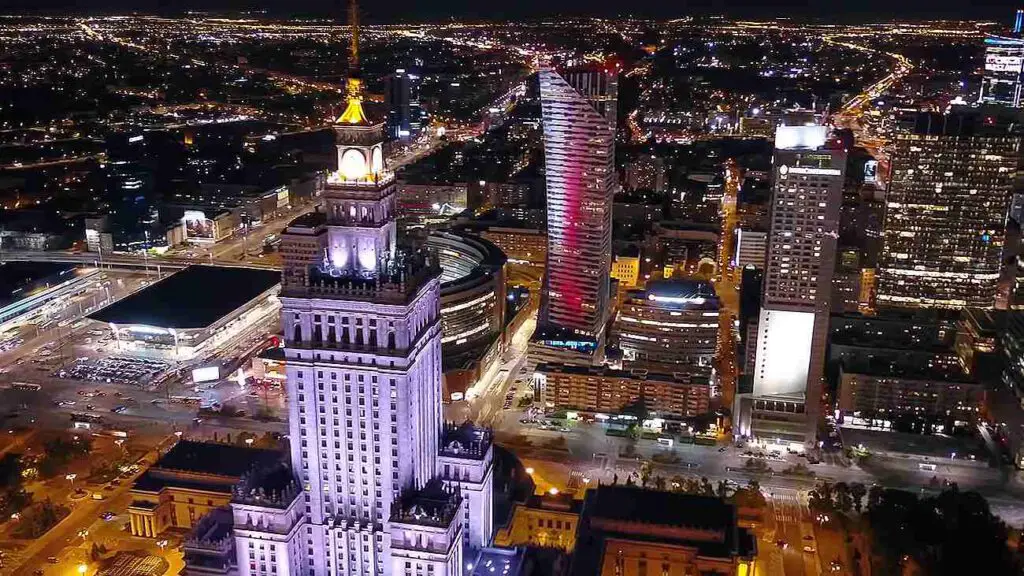
Continuing our voyage through Polish voivodships, we land next in Wielkopolskie, the second-largest voivodship. The capital is Poznań, and the entire region is an impressive 30.3 thousand square km.
It’s home to just under 5.117 million people. That’s roughly 31 people per sq km. This vast region is made up of 226 counties and numerous communes.
Lubelskie Voivodeship
Next up is the Lubelskie Voivodeship, wrapping up the top three. It spans just over 25.2 thousand sq km. Despite its size, it’s a predominantly agricultural region with just over 85 million people. That’s an average density of about 24 folks per sq km.
Warmian-Masurian Voivodeship
Following Lubelskie is the Warmian-Masurian Voivodeship, famous for its breathtaking lakes. The capital here is Olsztyn. This voivodship is the second least populated in Poland, housing about 1.5 million people across its vast territory. Here, you’ll find on average only 60 people per sq km.
From West Pomeranian to Lower Silesia
Then comes the West Pomeranian Voivodeship with its capital in Szczecin. The entire region covers 22.8 thousand sq km and is home to about 1.7 million people. That puts the average density at 75 people per sq km.
The sixth largest voivodship in terms of area is Podlaskie, with Białystok serving as its capital. The whole region is somewhat underdeveloped and home to less than 1.2 million people spread across a little over 20.59 thousand sq km. This gives an average density of 200 people per sq km, making Podlasie the least populated region in the country.
Just a bit smaller, by only 19 sq km, is the province of Lower Silesia, with its capital in Wrocław. The area is just over 9 thousand sq km. Now, this region is a hot spot for tourists, thanks to its abundant historical buildings. Lower Silesia is home to less than 3 million people, and the population density averages out at 146 folks per sq km.
Pomeranian Voivodeship
The Pomeranian Voivodeship with its capital, Gdańsk. The whole region houses 2.3 million people. With an area of 18.3 thausand sq km, this translates into an average density of about 126 people per sq km.
Continuing with the stats, we next visit Łódzkie Voivodeship, which sits right in the center of Poland. Łódź, of course, is its capital. With an area of 18.2 thousand sq km and a population of less than 2.5 million people, it’s got a population density of 137 people per sq km.
Kujawsko-Pomorskie Voivodeship
Let me move you just a little west, to the unique Kujawsko-Pomorskie Voivodeship. Now, why unique, you ask? I think it’s worth saying that this region’s capital is a matter of dispute, yet to be resolved.
So, as things stand, the voivodship offices are divided between two cities, Bydgoszcz and Toruń. This region, with its 17.9 thousand sq km area, is home to a tad over 2 million people, so the population density is roughly 116 folks per sq km.
Podkarpackie Voivodeship
Next, we go to the country’s eastern border, landing in Podkarpackie Voivodeship. The capital here is Rzeszów. Nestled among its mountains and forests live 2.1 million people across an area slightly smaller than that of Łódź at 17.8 thousand sq km. This results in a population density of about 119 people per sq km.
Małopolska and Lubuskie Voivodeships
Believe it or not, Małopolska is smaller than Podkarpacie, but it’s much more densely populated. Here, 3.4 million people live within 15.1 thousand square km, making it the second most densely populated voivodeship with an average of 222 people per sq km.
Next on our list is the Lubuskie Voivodeship. This western region has two capitals – Gorzów Wielkopolski and Zielona Góra. It’s inhabited by just over a million people and holds the record as the second province with the smallest number of citizens, spreading across an area less than 14.73 thousand sq km. That’s about 12 people per sq km.
Silesian Voivodeship
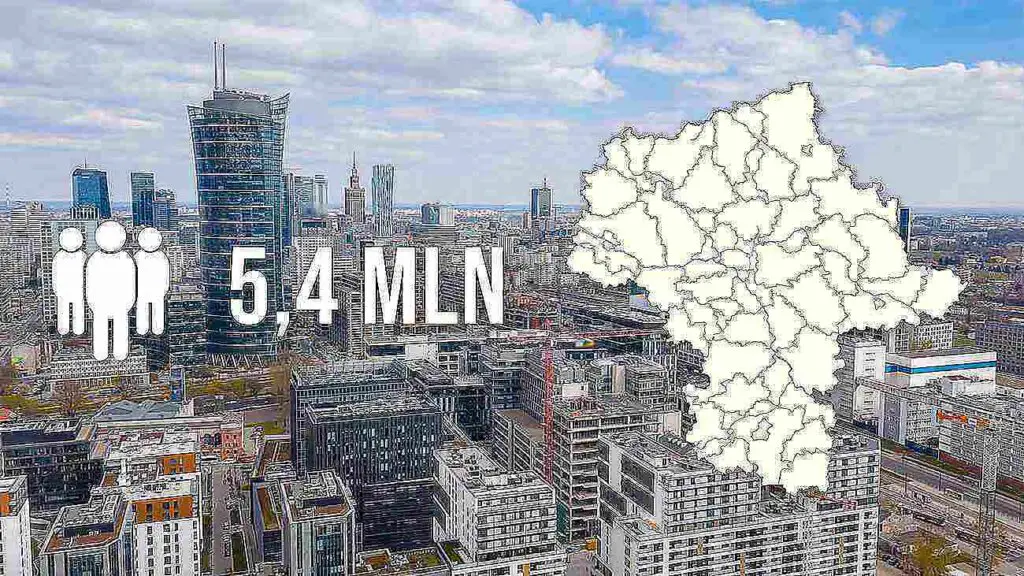
I am convinced you’ll find the Silesian Voivodeship interesting. Despite its small size of just 3.4 thousand sq km, it’s a beehive with over 5.371 million people. That means there are about 150 people per sq km, quite a leap from Podkarpacie. The capital of this bustling region is Katowice.
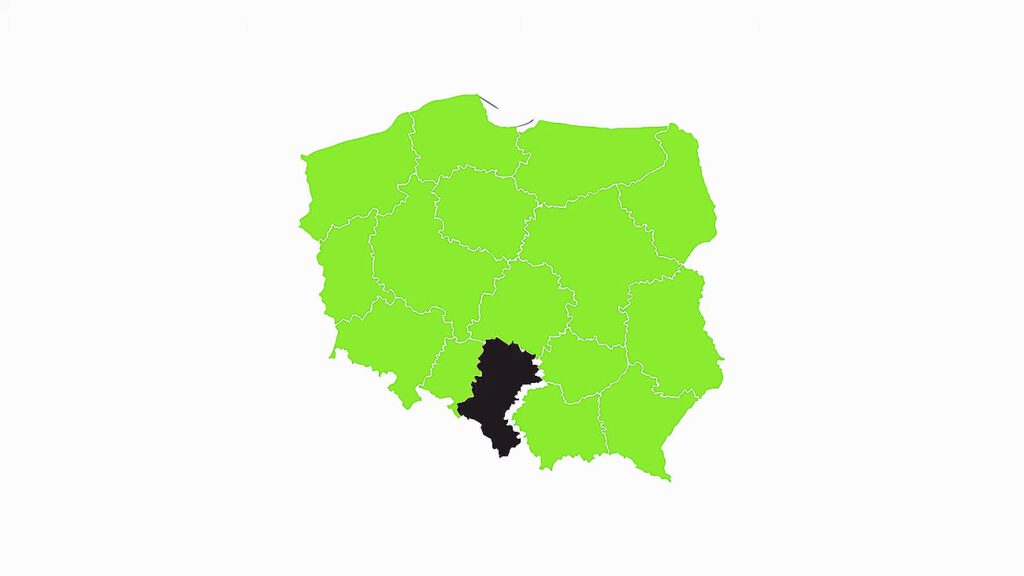
Świętokrzyskie and Opolskie Voivodeships
And finally, if you need to know the smallest voivodships, they are Świętokrzyskie and Opolskie. Their capitals are Kielce and Opole, and their respective areas are 11.7 and 9.4 thousand sq km. These regions are home to 1.2 and 0.9 million people, respectively, resulting in densities of about 107 and 106 folks per sq km.
Powiats in Poland
Next up on our journey, we’ve got the powiats. These are a bit larger than a commune and are pretty vital in the country’s structure. One powiat bundles together neighboring municipalities under its rule. In total, there are 380 powiats, and among these, there are 66 special ones. I can tell you these are known as town counties. In other words, they are cities that stand as separate powiats.
Now, if we remove these town counties from the count, we’re left with 314 powiats, each grouping a few to a dozen or so communes. These are fondly referred to as land districts. It’s also worth saying that the land districts’ headquarters might be in a city with powiat rights, even if it’s outside their area.
References:
- https://stat.gov.pl/statystyka-regionalna/jednostki-terytorialne/podzial-administracyjny-polski/
- https://pl.wikipedia.org/wiki/Podzia%C5%82_administracyjny_Polski



